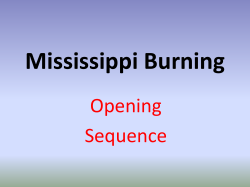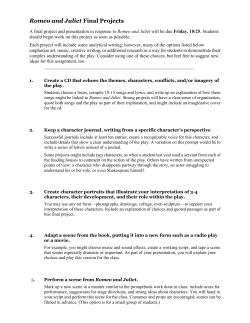
Tone-Mapping Operators psychophysical study
Xim Cerdá, C. Alejandro Párraga, Xavier Otazu Dept. Ciències de la Computació – Centre de Visió per Computador Univ. Autònoma de Barcelona, Spain. http://www.cvc.uab.cat Which tone-mapping is the best? A comparative study of tone-mapping perceived quality Motivation Laboratory Setup High-dynamic-range (HDR) imaging refers to the methods designed to increase the dynamic range present in standard digital imaging techniques. This increase is achieved by taking the same picture under different exposure values and mapping the resulting HDR intensity levels into a single Lowdynamic-range (LDR) image by way of a tone-mapping operator (TMO). • Calibrated CRT Monitor: Mitsubishi Diamond-Pro 2045u • 10 participants (4 females, 6 males, age between 17-54 y.o.) Dark Room • ViSaGe MKI Stimulus Generator • 3 different man-made scenes with grey and colored objects • Sigma SD10 Camera Currently, there is no agreement on how to evaluate the quality of different TMOs. In this work we psychophysically evaluate 15 different TMOs obtaining rankings based on the perceived properties of the resulting tone-mapped images. 5 • Reference Table (65 grey-level patches) • Sigma Photo Pro LDR image of HDR scene, without using tonemapping operator (left) and using one (right). Our criteria is that the best TMO should be the one that perceptually reproduces the real scene best. Calibrated Monitor displaying Tone-Mapped Image • HDR Toolbox for Matlab • Grey objects: 15 different surfaces (5 in each of the 3 scenes) Real Scene Methods & Results Exp 1: Grey-Levels Matching Exp 2: Pairwise Comparison Objective Objective To study the INTERNAL relationships among grey-levels in the tone-mapped image and in the real scene and to construct a ranking of tone mapping operators according to these relationships. To study the GLOBAL characteristics that determine whether a TMO image is more or less similar to the real scene and to rank the best perceptual tone-mapping operators. Procedure 1. A printed grey-level reference table was created and included in all scenes. The luminance of its patches was measured using a spectroradiometer. Table 1: Reference Table Luminance (cd/m2) 100 90 We performed a pairwise comparison between 15 tone-mapped images obtained applying the different algorithms. Each pair was presented besides the real scene and we asked subjects to choose the most realistic image. Results 80 2. Subjects were asked to match (in the real scene) the greylevels of object’s surfaces to the grey-levels of the reference table. Procedure 70 Luminance Interpolated (cd/m2) 60 50 LAB space values Using the 5th case of Thurstone’s law, we obtained a ranking for each scene and a global one. SCENE 1 40 3. Subjects conducted the same task using the tone-mapped image presented on the monitor screen. 30 20 10 4. Results were converted to cd/m2 using Table 1. 0 1 6 11 16 21 26 31 36 41 46 51 56 61 66 71 (patch number) Results Table 1: luminance of each patch in the reference table as measured by the spectroradiometer. 1. We obtained 16 values (corresponding to the 15 TMO algorithms plus the real scene) for each of the 15 surfaces considered. 2. 15 different ANOVAs were calculated, (one per grey-level surface and scene) and Fisher's Least Significant Difference (LSD) post-hoc analysis was applied to obtain a ranking. 3. All observer’s results were averaged (one value for each surface and TMO) and a PCA was applied: 15 dimensions were reduced to 6 and another ranking was obtained by measuring the Euclidean distance in the new space from every TMO to the real scene. 4. A Spearman’s correlation between the two rankings was calculated (p<0.05, Table 2) ANOVA Eigenvalues scree plot PCA 8 7 TMO Score TMO Eucl.Dist 44,9589% 6 TMO KimKautz Reinhard Krawczyk Ferwerda Drago Ferradans Li Otazu iCAM Durand Meylan Reinhard-Devlin Ashikhmin Mertens Fattal SCENE 2 Score TMO SCENE 3 Score TMO 6.92 Krawczyk 7.50 Krawczyk 6.93 6.85 KimKautz 7.35 Ferradans 6.71 6.74 Reinhard 7.06 KimKautz 6.57 6.72 Ferwerda 6.45 Reinhard 6.39 6.01 Ferradans 6.28 Drago 6.19 5.52 Drago 5.82 Ferwerda 5.70 5.41 Li 5.38 Durand 4.97 4.50 Otazu 4.15 Li 4.65 4.50 iCAM 3.73 Otazu 4.12 4.09 Durand 3.59 iCAM 4.03 1.74 Mertens 1.25 Mertens 1.42 1.53 Reinhard-Devlin 0.92 Reinhard-Devlin 1.12 1.24 Meylan 0.83 Meylan 1.12 0.14 Ashikhmin 0.43 Ashikhmin 1.04 0 Fattal 0 Fattal 0 14 iCAM 2.26 Ferradans 11 Durand 4.26 Eigenvalues 5 iCAM 3 10 Fattal 4.52 6,6857% 1 3,5567% 2,3371% 0 Durand 9 Li 4.85 -1 1 Fattal 9 Krawczyk 9 Mertens Mertens 2 4.96 9 Krawczyk 5.16 Reinhard-Devlin 9 Reinhard 5.24 Li 9 Meylan 5.27 Drago 8 Reinhard-Devlin 5.29 Meylan 8 Ferwerda 5.66 Otazu 8 Ferradans 5.91 Reinhard 8 Drago 6.02 Ashikhmin 7 Otazu 6.22 Ferwerda 6 Ashikhmin 9.00 3 4 5 6 Component 4.89 KimKautz TMO 11,8502% 2 KimKautz GLOBAL We obtained the Spearman's rank correlation coefficients (p<0.05) between the rankings of the scenes. 26,0150% 4 PCA components, corresponding eigenvalues and percentage total data represented by every component. The 95.40% of data could be represented in 6 components. Spearman’s Ranking Ranking Correlation PCA ANOVA Ranking PCA Ranking ANOVA 1.000 Since correlations were higher or equal than 0.90, we generated a global ranking, based on the different scene’s rankings. Spearman’s Scene 1 Correlation Scene 1 Scene 2 0.616 Scene 2 1.00 0.96 0.96 1.00 Scene 3 Global 0.90 0.95 0.98 0.97 0.616 Scene 3 0.90 0.95 1.00 0.94 1.000 Global Score 0.98 0.97 0.94 Table 2: Spearman’s correlation of PCA and ANOVA rankings is significant at p<0.05. 1.00 Score KimKautz 6.73 Krawczyk 6.61 Reinhard 6.56 Ferwerda 5.96 Drago 5.85 Ferradans 5.64 Li 4.84 Durand 4.50 iCAM 4.24 Otazu 4.19 Reinhard-Devlin 1.70 Meylan 1.63 Mertens 1.38 Ashikhmin 1.12 Fattal 0 Conclusions In Experiment 1 the best algorithm was ICAM by J.Kuang et al (2007) and in Experiment 2 the three top algorithms (which differed by less than a jnd) were KimKautz (Kim and Kautz, 2008), Krawczyk (Krawczyk et al, 2005) and Reinhard (Reinhard et al, 2002). Our results also show no correlation between the rankings produced by these two experiments. With the possible exception of KimKautz (3rd, 6th, 1st), no single algorithm comes near the top of the ranking in all these metrics or is capable of scoring high for both the global and local criteria analysed. Our results also suggest that these algorithms may have been defined using different criteria, depending on the aim of their authors. For example, it might be possible that iCAM was defined taking into account a local criterion, while Krawczyk was defined using a global one. We conclude that an agreed standard criteria is needed for defining tone-mapping operators and this method should take into account some local and global characteristics of the image. As a corollary, we consider there is ample room for improvement in the future development of TMO algorithms. References Acknowledgements Ashikhmin, M. , "A Tone Mapping Algorithm for High Contrast Images", Thirteenth Eurographics Workshop on Rendering, 2002. Kim, M.H. and Kautz, J., "Consistent Tone Reproduction", Proc. Computer Graphics and Imaging, 2008. Banterle, F. et al., "Advanced High Dynamic Range Imaging: Theory and Practice", AK Peters, CRC Press, 2011. Krawczyk, G. et al., "Lightness Perception in Tone Reproduction for High Dynamic Range Images", Proc. of EUROGRAPHICS, vol. 24(3), 2005. Drago, F. et al., "Adaptive Logarithmic Mapping For Displaying High Contrast Scenes", Proc. of EUROGRAPHICS, vol. 22 of Comp. Graph. 419-426, 2003. Li, Y. et al., "Compressing and Compading High Dynamic Range Images with Subband Architectures", ACM Trans. Graph., vol. 24, no.3, pp. 836- 844, 2005. Durand, F. and Dorsey, J., "Fast Bilateral Filtering for the Display of High-Dynamic-Range Images", In Proc. of ACM SIGGRAPH, ACM Press, 257-266, 2002. Mertens, T. et al., "Exposure Fusion", 15th Pacific Conf. on Comp. Graph. and Applications, pp. 382- 390, 2007. Fattal, R. et al., "Gradient Domain High Dynamic Range Compression", In Proc. of ACM SIGGRAPH , ACM Press, 249-256, 2002. Meylan, L. et al., "Model of retinal local adaptation for the tone mapping of color filter array images", J. Opt. Soc. Am. A, vol. 24, no. 9, 2007. Ferwerda, J.A. et al., "A Model of Visual Adaptation for Realistic Image Synthesis", In Proc. of ACM SIGGRAPH, ACM Press, 249-258, 1996. Otazu, X., "Perceptual tone-mapping operator based on multiresolution contrast decomposition", Perception, vol.41, pp. 86 Suppl, 2012. Ferradans, S. et al., "An Analysis of Visual Adaptation and Contrast Perception for Tone Mapping", TPAMI, vol. 33, no. 10, 2011. Reinhard, E. and Devlin, K. , "Dynamic Range Reduction inspired by Photoreceptor Physiology", IEEE Trans. on Vis. Comp. Graph, vol. 11 (1), pp. 13-24, 2005. Kuang, J. et al., "iCAM06: A refined image appearance model for HDR image rendering", J. Vis. Commun. image R. 18, 406-414, 2007. Reinhard, E. et al., "Photographic Tone Reproduction for Digital Images", ACM Trans.on Graphics, vol. 21, no.3 pp. 267-276, 2002. CAP and XO are partially supported by the Spanish Ministry of Science and Innovation through research project TIN2010-21771-C02-01 and TIN2013-41751.
© Copyright 2025









